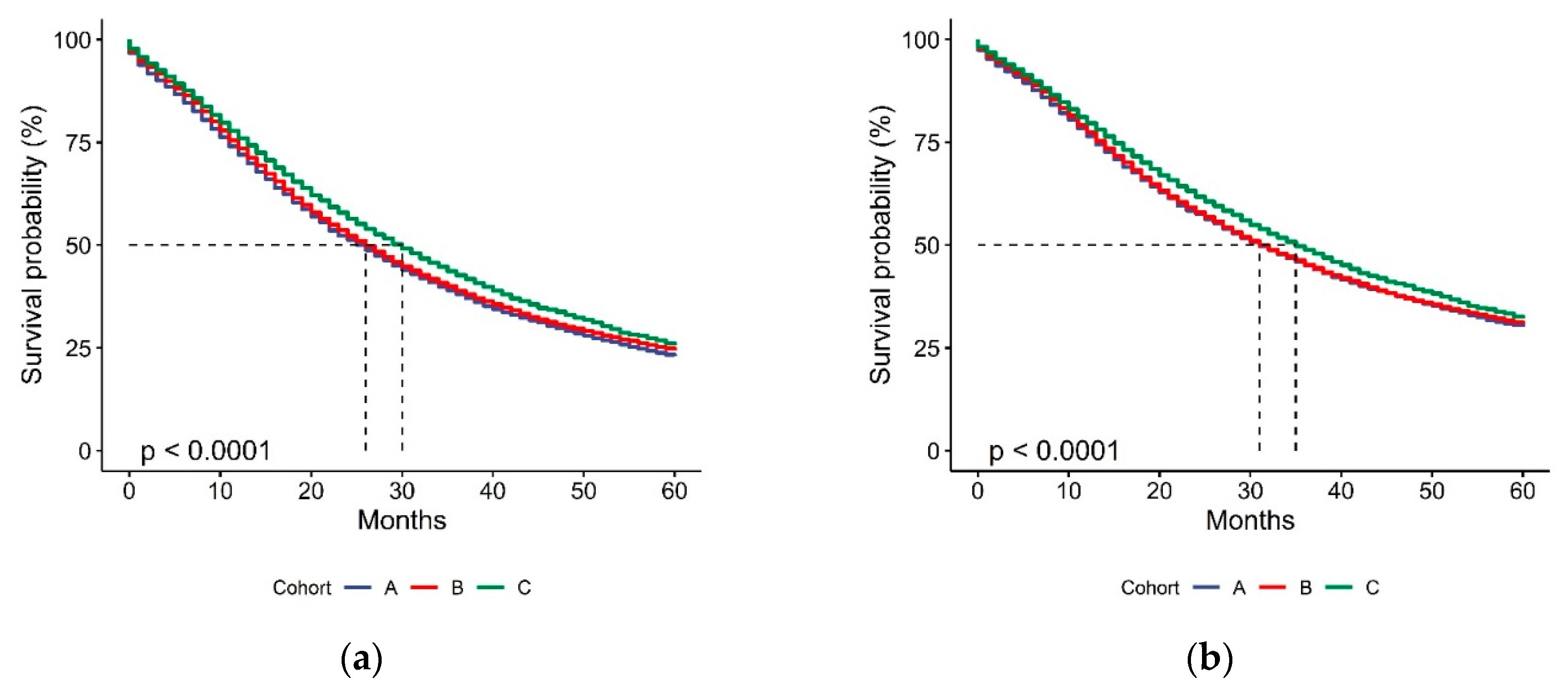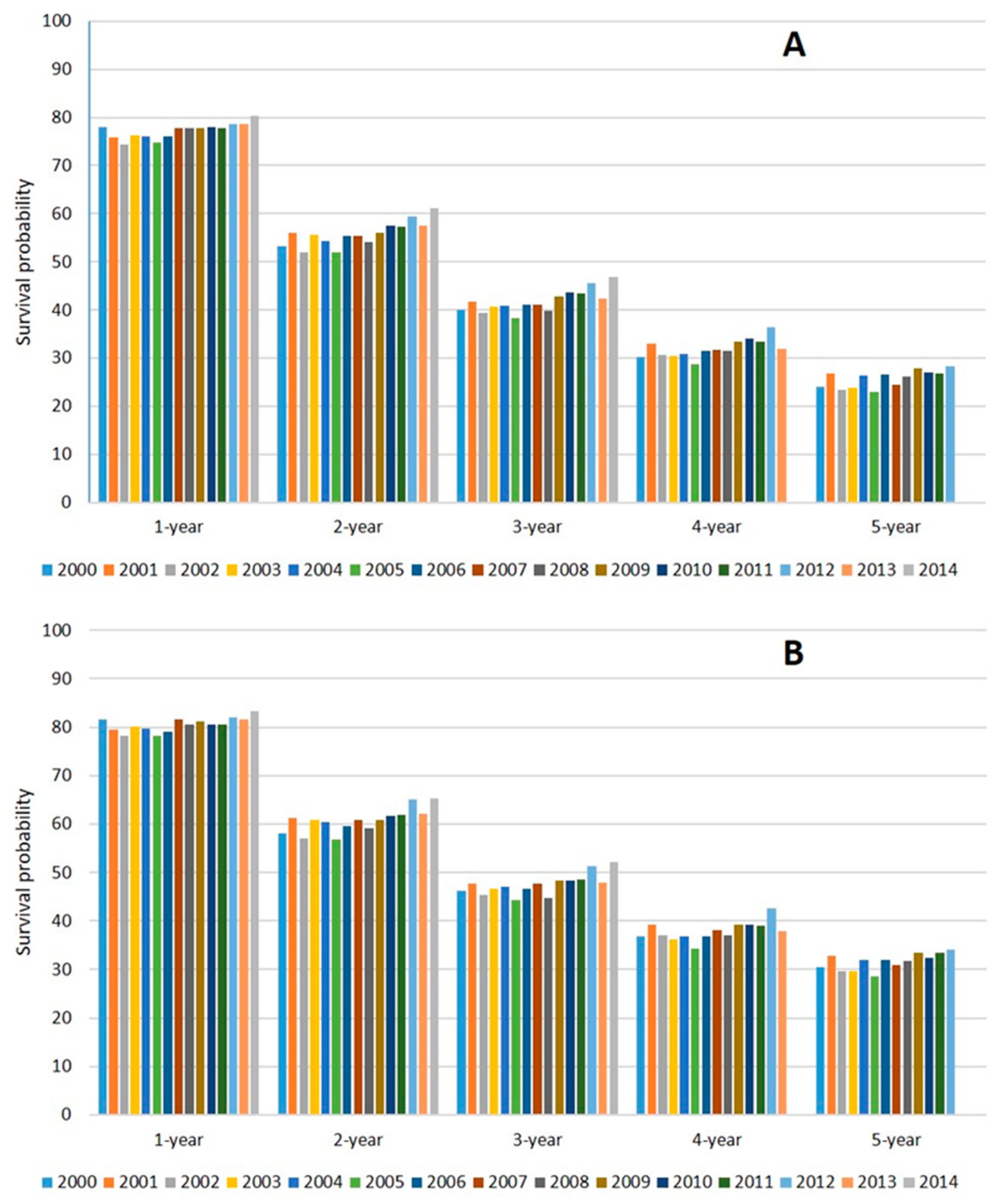Epidemiological Characteristics and Survival in Patients with De Novo Metastatic Prostate Cancer
Simple Summary
Abstract
1. Introduction
2. Results
2.1. Study Cohort
2.2. Clinical Outcome and Prognostic Variables
2.3. Multivariable Models
3. Discussion
4. Patients and Methods
5. Conclusions
Supplementary Materials
Author Contributions
Funding
Acknowledgments
Conflicts of Interest
References
- Tannock, I.F.; de Wit, R.; Berry, W.R.; Horti, J.; Pluzanska, A.; Chi, K.N.; Oudard, S.; Theodore, C.; James, N.D.; Turesson, I.; et al. Docetaxel plus prednisone or mitoxantrone plus prednisone for advanced prostate cancer. N. Engl. J. Med. 2004, 351, 1502–1512. [Google Scholar] [CrossRef]
- De Bono, J.S.; Oudard, S.; Ozguroglu, M.; Hansen, S.; Machiels, J.P.; Kocak, I.; Gravis, G.; Bodrogi, I.; Mackenzie, M.J.; Shen, L.; et al. Prednisone plus cabazitaxel or mitoxantrone for metastatic castration-resistant prostate cancer progressing after docetaxel treatment: A randomised open-label trial. Lancet 2010, 376, 1147–1154. [Google Scholar] [CrossRef]
- De Bono, J.S.; Logothetis, C.J.; Molina, A.; Fizazi, K.; North, S.; Chu, L.; Chi, K.N.; Jones, R.J.; Goodman, O.B., Jr.; Saad, F.; et al. Abiraterone and increased survival in metastatic prostate cancer. N. Engl. J. Med. 2011, 364, 1995–2005. [Google Scholar] [CrossRef] [PubMed]
- Scher, H.I.; Fizazi, K.; Saad, F.; Taplin, M.E.; Sternberg, C.N.; Miller, K.; de Wit, R.; Mulders, P.; Chi, K.N.; Shore, N.D.; et al. Increased survival with enzalutamide in prostate cancer after chemotherapy. N. Engl. J. Med. 2012, 367, 1187–1197. [Google Scholar] [CrossRef] [PubMed]
- Ryan, C.J.; Smith, M.R.; de Bono, J.S.; Molina, A.; Logothetis, C.J.; de Souza, P.; Fizazi, K.; Mainwaring, P.; Piulats, J.M.; Ng, S.; et al. Abiraterone in metastatic prostate cancer without previous chemotherapy. N. Engl. J. Med. 2013, 368, 138–148. [Google Scholar] [CrossRef] [PubMed]
- Beer, T.M.; Armstrong, A.J.; Rathkopf, D.E.; Loriot, Y.; Sternberg, C.N.; Higano, C.S.; Iversen, P.; Bhattacharya, S.; Carles, J.; Chowdhury, S.; et al. Enzalutamide in metastatic prostate cancer before chemotherapy. N. Engl. J. Med. 2014, 371, 424–433. [Google Scholar] [CrossRef] [PubMed]
- Sweeney, C.J.; Chen, Y.H.; Carducci, M.; Liu, G.; Jarrard, D.F.; Eisenberger, M.; Wong, Y.N.; Hahn, N.; Kohli, M.; Cooney, M.M.; et al. Chemohormonal Therapy in Metastatic Hormone-Sensitive Prostate Cancer. N. Engl. J. Med. 2015, 373, 737–746. [Google Scholar] [CrossRef] [PubMed]
- Cattrini, C.; Castro, E.; Lozano, R.; Zanardi, E.; Rubagotti, A.; Boccardo, F.; Olmos, D. Current Treatment Options for Metastatic Hormone-Sensitive Prostate Cancer. Cancers 2019, 11, 1355. [Google Scholar] [CrossRef] [PubMed]
- Mottet, N.; Bellmunt, J.; Briers, E.; Bolla, M.; Bourke, L.; Cornford, P.; De Santis, M.; Henry, A.; Joniau, S.; Lam, T. Members of the EAU–ESTRO–ESUR–SIOG Prostate Cancer Guidelines Panel. EAU–ESTRO–ESUR–SIOG Guidelines on Prostate Cancer; Presented at the EAU Annual Congress Amsterdam 2020. 978-94-92671-07-3; EAU Guidelines Office: Arnhem, The Netherlands, 2020. [Google Scholar]
- Thompson, A.L.; Sarmah, P.; Beresford, M.J.; Jefferies, E.R. Management of metastatic prostate cancer in the elderly: Identifying fitness for chemotherapy in the post-STAMPEDE world. Bju Int. 2017, 120, 751–754. [Google Scholar] [CrossRef] [PubMed]
- Francini, E.; Gray, K.P.; Shaw, G.K.; Evan, C.P.; Hamid, A.A.; Perry, C.E.; Kantoff, P.W.; Taplin, M.E.; Sweeney, C.J. Impact of new systemic therapies on overall survival of patients with metastatic castration-resistant prostate cancer in a hospital-based registry. Prostate Cancer Prostatic Dis. 2019, 22, 420–427. [Google Scholar] [CrossRef] [PubMed]
- Ramsey, S.D.; Bansal, A.; Fedorenko, C.R.; Blough, D.K.; Overstreet, K.A.; Shankaran, V.; Newcomb, P. Financial Insolvency as a Risk Factor for Early Mortality among Patients with Cancer. J. Clin. Oncol. 2016, 34, 980–986. [Google Scholar] [CrossRef] [PubMed]
- Helgstrand, J.T.; Roder, M.A.; Klemann, N.; Toft, B.G.; Lichtensztajn, D.Y.; Brooks, J.D.; Brasso, K.; Vainer, B.; Iversen, P. Trends in incidence and 5-year mortality in men with newly diagnosed, metastatic prostate cancer-A population-based analysis of 2 national cohorts. Cancer 2018, 124, 2931–2938. [Google Scholar] [CrossRef] [PubMed]
- Francini, E.; Gray, K.P.; Xie, W.; Shaw, G.K.; Valenca, L.; Bernard, B.; Albiges, L.; Harshman, L.C.; Kantoff, P.W.; Taplin, M.E.; et al. Time of metastatic disease presentation and volume of disease are prognostic for metastatic hormone sensitive prostate cancer (mHSPC). Prostate 2018, 78, 889–895. [Google Scholar] [CrossRef] [PubMed]
- Finianos, A.; Gupta, K.; Clark, B.; Simmens, S.J.; Aragon-Ching, J.B. Characterization of Differences Between Prostate Cancer Patients Presenting with De Novo Versus Primary Progressive Metastatic Disease. Clin. Genitourin. Cancer 2017, 16, 85–89. [Google Scholar] [CrossRef] [PubMed]
- Becker, D.J.; Iyengar, A.D.; Punekar, S.R.; Ng, J.; Zaman, A.; Loeb, S.; Becker, K.D.; Makarov, D. Treatment of Metastatic Castration-resistant Prostate Cancer with Abiraterone and Enzalutamide Despite PSA Progression. Anticancer Res. 2019, 39, 2467–2473. [Google Scholar] [CrossRef] [PubMed]
- De Wit, R.; de Bono, J.; Sternberg, C.N.; Fizazi, K.; Tombal, B.; Wulfing, C.; Kramer, G.; Eymard, J.C.; Bamias, A.; Carles, J.; et al. Cabazitaxel versus Abiraterone or Enzalutamide in Metastatic Prostate Cancer. N. Engl. J. Med. 2019, 381, 2506–2518. [Google Scholar] [CrossRef] [PubMed]
- De Bono, J.; Mateo, J.; Fizazi, K.; Saad, F.; Shore, N.; Sandhu, S.; Chi, K.N.; Sartor, O.; Agarwal, N.; Olmos, D.; et al. Olaparib for Metastatic Castration-Resistant Prostate Cancer. N. Engl. J. Med. 2020, 382, 2091–2102. [Google Scholar] [CrossRef] [PubMed]
- Messina, C.; Cattrini, C.; Soldato, D.; Vallome, G.; Caffo, O.; Castro, E.; Olmos, D.; Boccardo, F.; Zanardi, E. BRCA Mutations in Prostate Cancer: Prognostic and Predictive Implications. J. Oncol. 2020, 2020, 4986365. [Google Scholar] [CrossRef] [PubMed]
- Surveillance, Epidemiology, and End Results (SEER) Program (www.seer.cancer.gov) SEER*Stat Database: Incidence-SEER Research Data, 18 Registries, Nov 2019 Sub (2000–2017)-Linked to County Attributes-Time Dependent (1990–2017) Income/Rurality, 1969–2017 Counties; National Cancer Institute, DCCPS, Surveillance Research Program, Released April 2020, Based on the November 2019 Submission. Available online: https://seer.cancer.gov/data/citation.html (accessed on 3 October 2020).



| Variables | Number of Patients (%) | ||||
|---|---|---|---|---|---|
| Total | 2000–2003 | 2004–2010 | 2011–2014 | ||
| Age (years) | 15–54 | 2087 (7.9) | 474 (7.8) | 970 (8.2) | 643 (7.5) |
| 55–64 | 6323 (23.9) | 1250 (20.7) | 2857 (24.2) | 2216 (25.9) | |
| 65–74 | 7892 (29.9) | 1804 (29.8) | 3391 (28.7) | 2697 (31.5) | |
| 75–84 | 7099 (26.9) | 1862 (30.8) | 3268 (27.7) | 1969 (23.0) | |
| ≥85 | 3033 (11.5) | 657 (10.9) | 1329 (11.2) | 1047 (12.2) | |
| Total | 26,434 (100) | 6047 (100) | 11,815 (100) | 8572 (100) | |
| Race | White | 16,513 (62.7) | 3830 (63.5) | 7361 (62.5) | 5322 (62.3) |
| Black | 5111 (19.4) | 1227 (20.3) | 2279 (19.3) | 1605 (18.8) | |
| Am. Indian/Alaska Native | 170 (0.6) | 31 (0.5) | 76 (0.6) | 63 (0.7) | |
| Asian or Pacific Islander | 1484 (5.6) | 329 (5.4) | 680 (5.8) | 475 (5.6) | |
| Hispanic | 3066 (11.6) | 614 (10.2) | 1377 (11.7) | 1075 (12.6) | |
| Total | 26,344 (100) | 6031 (100) | 11,773 (100) | 8540 (100) | |
| Metastatic stage | M1a | 1097 (5.6) | - | 610 (5.3) | 487 (5.9) |
| M1b | 14,301 (72.7) | - | 8011 (70.1) | 6290 (76.4) | |
| M1c | 4265 (21.7) | - | 2811 (24.6) | 1454 (17.7) | |
| Total | 19,663 (100) | - | 11,432 (100) | 8231 (100) | |
| Variables | Number of Patients | HR | 95% CI | p | ||
|---|---|---|---|---|---|---|
| Lower | Upper | |||||
| Age (years) | 15–54 | 2081 | <0.001 | |||
| 55–64 | 6300 | 0.98 | 0.92 | 1.04 | 0.515 | |
| 65–74 | 7857 | 1.03 | 0.97 | 1.09 | 0.286 | |
| 75–84 | 7078 | 1.42 | 1.34 | 1.50 | <0.001 | |
| ≥85 | 3028 | 2.18 | 2.04 | 2.32 | <0.001 | |
| Race | White | 16,513 | <0.001 | |||
| Black | 5111 | 1.10 | 1.06 | 1.14 | <0.001 | |
| Am. Indian/Alaska Native | 170 | 1.08 | 0.91 | 1.28 | 0.393 | |
| Asian or Pacific Islander | 1484 | 0.74 | 0.69 | 0.79 | <0.001 | |
| Hispanic | 3066 | 0.94 | 0.90 | 0.98 | 0.010 | |
| Year of diagnosis | 2000–2003 (Cohort A) | 6031 | <0.001 | |||
| 2004–2010 (Cohort B) | 11,773 | 0.97 | 0.94 | 1.01 | 0.145 | |
| 2011–2014 (Cohort C) | 8540 | 0.91 | 0.87 | 0.95 | <0.001 | |
| Variables | Number of Patients | HR | 95% CI | p | ||
|---|---|---|---|---|---|---|
| Lower | Upper | |||||
| Age (years) | 15–54 | 2049 | <0.001 | |||
| 55–64 | 6216 | 0.94 | 0.88 | 0.99 | 0.048 | |
| 65–74 | 7720 | 0.93 | 0.88 | 0.99 | 0.033 | |
| 75–84 | 6979 | 1.20 | 1.12 | 1.27 | <0.001 | |
| ≥85 | 2987 | 1.74 | 1.62 | 1.87 | <0.001 | |
| Race | White | 16,376 | <0.001 | |||
| Black | 5053 | 1.09 | 1.04 | 1.13 | <0.001 | |
| Am. Indian/Alaska Native | 167 | 1.01 | 0.83 | 1.23 | 0.922 | |
| Asian or Pacific Islander | 1423 | 0.73 | 0.67 | 0.78 | <0.001 | |
| Hispanic | 2932 | 0.95 | 0.91 | 1.00 | 0.076 | |
| Year of diagnosis | 2000–2003 (Cohort A) | 5928 | <0.001 | |||
| 2004–2010 (Cohort B) | 11,599 | 0.99 | 0.95 | 1.03 | 0.596 | |
| 2011–2014 (Cohort C) | 8424 | 0.92 | 0.88 | 0.96 | <0.001 | |
| 2011–2014 (Cohort C) vs. 2004–2010 (Cohort B) | Number of Patients | HR | 95% CI | p | ||
|---|---|---|---|---|---|---|
| Lower | Upper | |||||
| OS Metastatic Stage | M1a | 1088 | 1.09 | 0.93 | 1.28 | 0.014 * |
| M1b | 14,250 | 0.96 | 0.92 | 0.99 | ||
| M1c | 4254 | 0.87 | 0.81 | 0.94 | ||
| All 1 | 19,592 | 0.94 | 0.91 | 0.97 | 0.001 | |
| CSS Metastatic Stage | M1a | 1069 | 1.01 | 0.85 | 1.20 | 0.015 * |
| M1b | 14,050 | 0.91 | 0.87 | 0.95 | ||
| M1c | 4189 | 0.81 | 0.75 | 0.88 | ||
| All 1 | 19,308 | 0.89 | 0.85 | 0.92 | <0.001 | |
© 2020 by the authors. Licensee MDPI, Basel, Switzerland. This article is an open access article distributed under the terms and conditions of the Creative Commons Attribution (CC BY) license (http://creativecommons.org/licenses/by/4.0/).
Share and Cite
Cattrini, C.; Soldato, D.; Rubagotti, A.; Zinoli, L.; Zanardi, E.; Barboro, P.; Messina, C.; Castro, E.; Olmos, D.; Boccardo, F. Epidemiological Characteristics and Survival in Patients with De Novo Metastatic Prostate Cancer. Cancers 2020, 12, 2855. https://doi.org/10.3390/cancers12102855
Cattrini C, Soldato D, Rubagotti A, Zinoli L, Zanardi E, Barboro P, Messina C, Castro E, Olmos D, Boccardo F. Epidemiological Characteristics and Survival in Patients with De Novo Metastatic Prostate Cancer. Cancers. 2020; 12(10):2855. https://doi.org/10.3390/cancers12102855
Chicago/Turabian StyleCattrini, Carlo, Davide Soldato, Alessandra Rubagotti, Linda Zinoli, Elisa Zanardi, Paola Barboro, Carlo Messina, Elena Castro, David Olmos, and Francesco Boccardo. 2020. "Epidemiological Characteristics and Survival in Patients with De Novo Metastatic Prostate Cancer" Cancers 12, no. 10: 2855. https://doi.org/10.3390/cancers12102855
APA StyleCattrini, C., Soldato, D., Rubagotti, A., Zinoli, L., Zanardi, E., Barboro, P., Messina, C., Castro, E., Olmos, D., & Boccardo, F. (2020). Epidemiological Characteristics and Survival in Patients with De Novo Metastatic Prostate Cancer. Cancers, 12(10), 2855. https://doi.org/10.3390/cancers12102855







